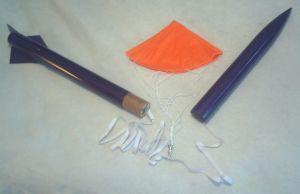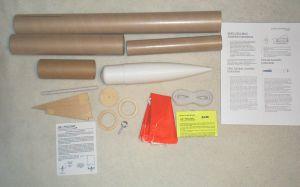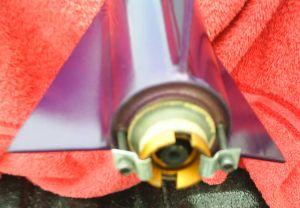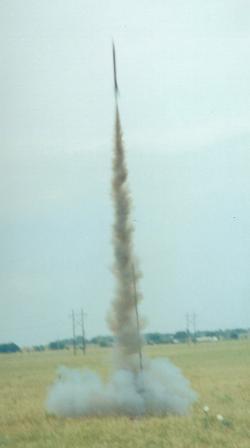| Construction Rating: | starstarstarstarstar |
| Flight Rating: | starstarstarstarstar |
| Overall Rating: | starstarstarstarstar |
| Manufacturer: | LOC/Precision  |

Brief:
This is a simple to construct single stage, mid to high power rocket with a
payload section and through the wall fin design. Kit is designed to use motor
ejection for parachute deployment. A 38mm motor mount is included with the kit.
A motor mount adapter is not included for the use of 29mm motors.
Construction:
Kit components come packaged in a heavy duty bag and include: Two LOC heavy
duty glassine coated paper tubes for the airframe, one is 22" long and
pre-slotted for through the wall construction of the fins and the other tubing
is 12" long and intended for the payload section. There are also three
pre-cut plywood fins, two plywood 38mm centering rings, one plywood bulkhead,
one plastic nose cone, 18" nylon parachute, 10" of 38mm LOC glassine
coated paper tube for the motor mount, 17' of 1/2" flat elastic shock
cord, one 3/8" stainless steel eye hook for parachute attachment to
bulkhead, one 5.75" long coupler tube, and one 8.5" x 11" page
instruction sheet with three illustrations showing a rear view, a side exposed
view of centering ring/motor mount tube assembly in main airframe, and the
payload assembly.

I began construction by wicking the edges of the body tubes and motor mount with CA for added strength and to prevent the paper tubes from fraying during sanding. LOC instructions begin by requiring the modeler to remove the glassine coating from the MMT by peeling the coating off or sanding it down to allow for better adhesion of the epoxy. The MMT centering rings are sized to have this layer removed and fit very well. I opted to sand the glassine layer with 100 grit sandpaper and used 30 minute epoxy throughout the build. I added a third centering ring to provide support under the forward area of the fins in the event of hard landing to prevent a fin from crushing the body tube. The fin slots cut into the body tube were a little short and a quick sanding cleared this up. The coupler tube fit in the body tubes a little loosely so a thin layer of epoxy was used to build the OD of the coupler up.
I built the rocket mostly stock but did make some basic modifications. I added an ejection baffle system to the coupler tube to do away with using wadding. Since the kit came with a payload section, I used a zipperless design. I also attached rail buttons instead of using the 1/4" launch lug that is included in the kit.
The LOC/Precision instructions are minimal but complete and easy to follow. The assembly order is typical of most kits and begins with the motor mount assembly and then continues with adding the fins. Next is the payload section and attachment of LOC shock cord by tying one end to the nose cone and the other end to a small piece of nylon string that is glued to the inside of the body tube. Since I used a zipperless design I didn't use the LOC method of shock cord attachment to the body tube so I don't know if it works.
PROs: Very sturdy kit that builds quickly and easily, parts are good quality, and this rocket should stand up to many flights.
CONs: None.
Finishing:
Elmers Wood Finish was used to fill the small spirals in the body tubes and
fill the grain in the fins. Model Master Red Putty was used to fill the
imperfections on the nose cone and covering pass for the fin fillets. Several
coats of Rustoleum primer were sprayed and wet sanded for a smooth finish. The
intermediate coat was applied with Rustoleum Gloss White and this was followed
with several coats of Boyd Grape Pearl and finally three coats of Rustoleum
Clear Gloss was applied to protect to the coating and give the color depth.
PROs: The body tubes are of very good quality and very easy to work with and finish. The spirals are so small and shallow that just priming them would probably take care of them. The plywood fins are very easy to finish as well since there is very little exposed grain to deal with.
CONs: Decals do not come with the kit but are available for download at the LOC website if you want to make your own decals to match the rocket pictured on the instruction sheet.
Construction Rating: 5 out of 5
Flight:
LOC/Precision recommends the rocket be used with mid and high power engines up
to an I357. With the low weight of the rocket I would recommend sticking to the
manufacturer list unless you want to see this baby go mach.
Final weight came in at 20 ounces. With the 38mm motor tube this rocket can be launched with an Aerotech J350W-14 and per Rocksim can be sent to about 7000' and hit 960 mph.
PROs: Large variety of motors available for this kit and it's designed strong enough to handle them.
 CONs:
LOC recommends use of masking tape for friction fitting the motor into the
motor mount and I completely disagree. I never use the friction fit method for
retaining any motors above an Estes C or D. I installed two #4-40 brass
threaded inserts designed to accept machined Allen screws into the aft
centering ring and used small clips to hold the motor in place.
CONs:
LOC recommends use of masking tape for friction fitting the motor into the
motor mount and I completely disagree. I never use the friction fit method for
retaining any motors above an Estes C or D. I installed two #4-40 brass
threaded inserts designed to accept machined Allen screws into the aft
centering ring and used small clips to hold the motor in place.
Recovery:
I used the supplied elastic shock cord and the nylon chute supplied with the
kit. With an ejection baffle built into the rocket there was no need for a
chute protector or wadding which made prepping the rocket on launch day that
much easier and faster when getting it ready for flight.
 The parachute shroud
lines are not of the best quality but they work OK. The chute diameter is sized
correctly for the weight of the rocket. I added a small swivel to the chute and
it worked well. There wasn't any excessive rotation of the rocket on the way
down on any of the flights.
The parachute shroud
lines are not of the best quality but they work OK. The chute diameter is sized
correctly for the weight of the rocket. I added a small swivel to the chute and
it worked well. There wasn't any excessive rotation of the rocket on the way
down on any of the flights.
I flew the Nuke Pro-Maxx three times at the Jim Turner Memorial launch held at the McGregor Field near Waco, TX, and all three flights were outstanding. I began with a AT G33J-7 and followed up with a AT G104T-6 and then a CTI G69-9. The rocket handled each motor well and delays were right on the money.
Flight Rating: 5 out of 5
Summary:
This is an excellent rocket that meets the needs of a flyer interested in
getting into mid power rocketry. It is well designed, well built, and boosted
straight as an arrow.
PROs : Easy to build and easy to fly on different size fields with the large assortment of motors that can be used.
Cons: None.
Overall Rating: 5 out of 5
Other Reviews
- LOC/Precision Nuke Pro Maxx By Lance Alligood
The LOC/Precision Nuke Pro Maxx is a simple, robust high performing 3FNC mid/high power rocket that can fly on motors as little as an F all the way up to a the largest 38mm J motor that you can fit into the rocket. My big reason for getting this kick is that I fly a lot of H and I powered rockets. I prefer my rockets to be light and small as well. My USR Banshee only has a 29mm MMT, so ...
- LOC/Precision Nuke Pro Maxx By Philip Levanda
Brief: This is an extremely versatile high flyer. Capable of stable flight on as little as an F20 through J motors. It is 2.2 inches in diameter and 39.5 inches long. It has three sharp fins for a very sleek, fast look. Construction: The kit comes with a main and a payload body tube. The recovery system is a 28 inch parachute. The body tube is slotted and the fins slide through ...
 |
 |
Flights
 |
 |
Sponsored Ads
 |
 |












C.K. (December 5, 2005)